
The Palazzo Caravita di Sirignano is a monumental palace located at via Rione Sirignano 4, corner with along the strada Riviera di Chiaia in Naples, Italy.

The Palazzo Caravita di Sirignano is a monumental palace located at via Rione Sirignano 4, corner with along the strada Riviera di Chiaia in Naples, Italy.
The palace was constructed by 1535 by commission of Don Ferdinando Alarcon, Marquis della Valle, Count of Siracusa, a Spanish general known for his affair with Joanna of Aragon, Queen of Naples. The palace had multiple owners in the subsequent centuries: including the viceroy of Naples, the Marquis of Astorga, then the Mendoza family. During the 18th century, the building passed to Caracciolo di Torella and in the second decade of the 19th century was rebuilt by Antonio Annito. In 1838, the Prince Leopold, Count of Syracuse bought the property and commissioned architect Fausto Niccolini with reconstruction. The Grounds included 14 acres of land, and he had a theater built where the art-minded Count had recitals and performances. After 1860, the owner Luigi Compagna converted the palace into multiple residences. His son Francesco Compagna commissioned Ettore Vitale with subdivision of gardens into separate lots. In 1837, the Palazzo Caravita di Sirignano became home of the Tirrenia Navigation company. [1]
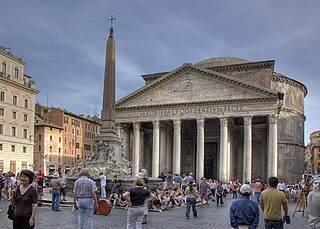
Pigna is the 9th rione of Rome, identified by the initials R. IX, and belongs to the Municipio I. The name means "pine cone" in Italian, and the symbol of the rione is the colossal bronze pine cone standing in the middle of the homonymous fountain. The fountain, which was initially located in the Baths of Agrippa, now decorates a vast niche in the wall of the Vatican facing the Cortile della Pigna, located in Vatican City.

Ferdinando Fuga was an Italian architect who was born in Florence, and is known for his work in Rome and Naples. Much of his early work was in Rome, notably, the Palazzo della Consulta (1732–7) at the Quirinal, the Palazzo Corsini (1736–54), the façade of the Santa Maria Maggiore (1741–3), and the Church of Sant'Apollinare (1742–8). He later moved to Naples and notably designed the Albergo de'Poveri (1751–81), the façade of the Church of the Gerolamini, and that of the Palazzo Giordano.
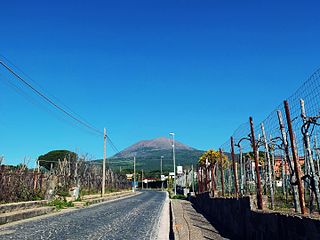
Boscotrecase is a town and municipality of 9,790 inhabitants in the metropolitan city of Naples in Campania, Italy.
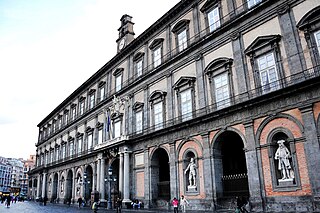
The Royal Palace of Naples is a palace, museum, and historical tourist destination located in central Naples, southern Italy.
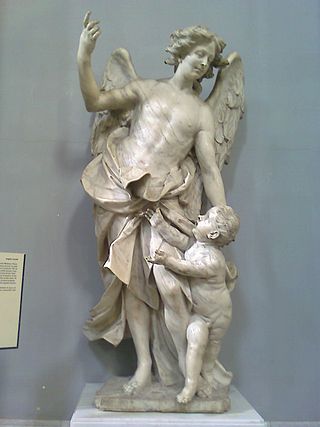
Domenico Antonio Vaccaro was an Italian painter, sculptor and architect. He created many important sculptural and architectural projects in Naples. His later works are executed in an individualistic Rococo style.

Palazzo Serra di Cassano is an aristocratic palace in Naples, Italy, built for the wealthy Serra family, one of the original 54 families of the 'old nobility' of Genoa, whose family was organized within an Albergo. The family insignia (crest) is frescoed on the ceiling of the Palazzo Serra's Great Hall. The family had economic interests in banking, insurance and law.
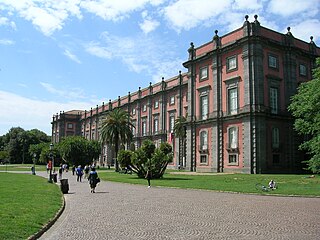
The Royal Palace of Capodimonte is a large palazzo in Naples, Italy. It was formerly the summer residence and hunting lodge of the Bourbon kings of the Two Sicilies, one of the two royal palaces in Naples. Today, it comprises the National Museum of Capodimonte and the Royal Forest. The palace was constructed on its somewhat cooler hilltop location just outside the city, with urban Naples ultimately expanding around it.

The Fontana del Gigante or Fountain of the Giant is a 17th-century fountain monument in Naples.
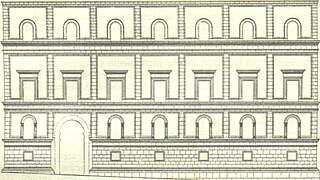
The Palazzo del Panormita is a Renaissance style palace in central Naples. It rises alongside the narrow via Nilo, near via Spaccanapoli, where it is called San Biagio dei Librai, diagonally from Santa Maria Assunta dei Pignatelli, adjacent to the Piazza del Nilo with the Nile God statue. It is south of Palazzo d’Afflitto and the Palazzo Spinelli di Laurino. The palace was initially commissioned prior to 1450 by Antonio Beccadelli, (1394–1471), called Il Panormita, who was a prominent Italian poet, canon lawyer, scholar, diplomat, and chronicler. It has since gone through many owners, including Giacomo Capece Galeota, a regent in the Tribunal of the Vicariate.

The Palazzo Orsini di Gravina is a Renaissance-style palace on number 3 Via Monteoliveto, in the San Lorenzo quarter of Rione San Giuseppe-Carità, of central Naples, Italy. Since 1940, it has housed the Faculty of Architecture of the University of Naples. It is located across the street and a few doors north of the sleek and modern Palazzo delle Poste. Across the street at the north end of the palace, is the Piazza Monteoliveto with its Fountain and the church of Sant'Anna dei Lombardi.
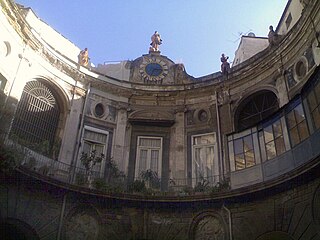
The Palazzo Spinelli di Laurino is a palace, located on the corner of Via Nilo and Via dei Tribunali in central Naples, Italy. A palace at the site was first built in the 15th century, but the present layout, with an elliptical interior courtyard was commissioned by Trojano Spinelli. The courtyard recalls the interior of Palazzo Farnese of Caprarola. The structure is much altered, but still contains in the interior courtyard, a hint of former grandeur with dual ramp staircases, and statuary depicting virtues along rooflines, and a maiolica clock face on a triangular pediment surmounted by a Virgin of the Immaculate Conception.
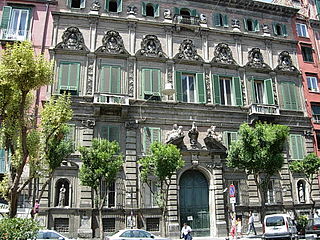
The Palazzo Firrao or Palazzo Bisignano, once called Palazzo di Santa Agata, is a monumental palace located on Via Santa Maria di Costantinopoli number 98, facing Piazza Bellini, in central Naples, Italy.
The Palazzo Marigliano, also known as Palazzo di Capua is a Renaissance-style palace in Central Naples, Italy. It is located on the Via San Biagio dei Librai number 39.
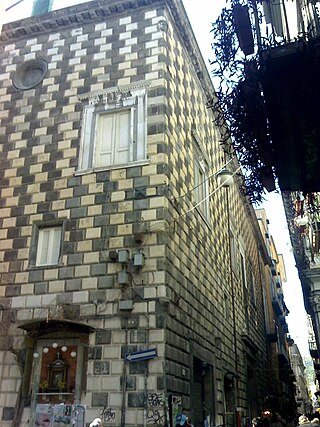
The Palazzo Diomede Carafa, also known as Palazzo Santangelo, or Santagelo Carafa, is a monumental Renaissance palace on Via San Biagio dei Librai #119–121 in central Naples, region of Campania, Italy. Across the street from the facade is the church of San Nicola a Nilo; on the Eastern flank, across a vicolo of the same name, is the church of Santi Filippo e Giacomo.

The Palazzo Ravaschieri di Satriano is a monumental palace on the Riviera di Chiaia number 287, in Naples, Italy.

The Palazzo Zevallos Stigliano is a Baroque palace located on Via Toledo number 185 in the quartiere San Ferdinando of central Naples, Italy. It is also called the Palazzo Zevallos or Palazzo Colonna di Stigliano, and since 2014 serves as a museum of artworks, mainly spanning the 17th through the early 20th centuries, sponsored by the Cultural Project of the bank Intesa Sanpaolo. This museum is linked to the Museum or Gallerie di Piazza Scala in Milan and the Museum at Palazzo Leoni Montanari in Vicenza, also owned by the Bank.

The d'Afflitto family is an ancient princely family originally from Amalfi, documented since the IX century, and spread throughout southern Italy.

Jan van den Eynde or Vandeneynden was a prominent Netherlandish merchant, banker, art collector, and patron of the arts. He was brother to Flemish merchant, art collector and art dealer Ferdinand van den Eynde, and father of the latter's namesake Ferdinand van den Eynde, Marquess of Castelnuovo. Van den Eynde's granddaughters were Elisabeth van den Eynde, Princess of Belvedere and Baroness of Gallicchio and Missanello, and Jane (Giovanna) van den Eynde, Princess of Galatro and Sonnino.

The Palazzo Paternò del Toscano, also known as the Palazzo del Toscano, is an notable palace in Piazza Stesicoro, in the center of Catania, region of Sicily, southern Italy. The building now houses many shops, but is also used by schools, and for cultural programs. The white stone facade stands before the Monument to Vincenzo Bellini and rises in contrast to the palace across via Aetna, the white and black Palazzo Tezzano.